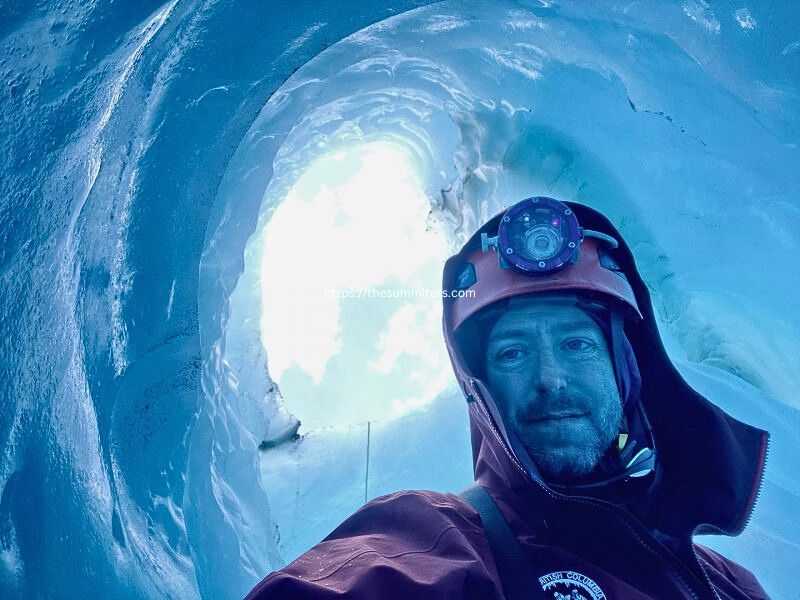In 2016, while flying over Job Glacier on Mount Meager in British Columbia, Canada, a helicopter pilot noticed a significant hole in the glacier. This discovery led to a unique project involving the study of volcanic activity beneath glaciers. Professor Williams-Jones, intrigued by the potential volcanic activity, needed someone skilled enough to venture into the glacio-volcanic cave for measurements. Christian Stenner, an experienced caver, emerged as one of the few individuals with the expertise required for this dangerous mission.

Stenner recently discussed the project with ExplorersWeb, shedding light on his journey from recreational caving to becoming a leading expert in glacio-volcanic caves.
Read More: Wojciech Kurtyka | Alpinist and Advocate of Alpine-Style Climbing
How did you enter the field of Glacio Volcanic Caves?
Stenner explained that his involvement stemmed from a combination of research and experience in caving and expeditions. The culture in the speleological community emphasizes mapping, and Stenner highlighted the interconnectedness of exploration and science in the realm of caving.
What prompted your involvement in the Mount Meager project?
Learning about the opening in the Canadian volcano’s glacier was enticing for Stenner and his team. The primary objective was to enter the cave, make observations, and safely exit. However, additional goals, such as taking biological samples and volcanic measurements, were successfully achieved using innovative equipment.

How do you manage the risks involved in such a dangerous project?
Stenner emphasized the importance of experience and preparation in mitigating risks. His prior exploration of glacial volcanic systems provided valuable insights. Time to plan and develop suitable equipment also played a crucial role. Stenner recounted the challenges faced in a rapidly changing cave environment, emphasizing the need for adaptability and trust in the equipment.
What were the key measurements taken on Mount Meager, and what do they signify?
Stenner discussed the significance of temperature and gas composition readings in assessing the volcano’s activity. These measurements help determine the proximity of the magma chamber to the surface and potential eruption risks. Stenner highlighted the critical importance of understanding the volcanic system, especially given Mount Meager’s proximity to populated areas.
From recreational caving to expertise in glacio volcanic caves – how did your journey unfold?
Stenner credited his early experiences with volcano expeditions and mentorship from Eddy Cartaya for shaping his expertise. Learning about glacier caves in the Pacific Northwest provided a foundation for tackling glacio-volcanic cave projects. Stenner emphasized the collaborative dynamic between cavers and scientists, recognizing the expertise each brings to the table.
How do you map a cave, especially in challenging environments?
Mapping caves presents unique challenges, as traditional GPS and radios may not function. Stenner explained the use of surveying techniques, including compass, inclinometer, and tape measure. More recently, lasers and LiDAR technology have been employed, though steam-filled environments can limit their effectiveness. The map created for Mount Meager combined LiDAR and compass measurements.
What qualities are essential for a successful caver?
Stenner highlighted the need for endurance, fitness, and mental resilience. Caving involves navigating challenging terrains with heavy packs, enduring discomfort, and confronting the isolation of being deep underground. The ability to cope with fear is crucial, and Stenner suggested drawing on past experiences to navigate challenging situations.
Can you recall a particularly nerve-wracking moment during the Mount Meager project?
Stenner described a tense moment when a column of steam unexpectedly shot out of the ground during temperature measurements. He highlighted the importance of staying calm, ensuring a secure air supply, and taking deliberate actions to address the high levels of volcanic gas exposure.

Despite the risks, what motivates you to continue exploring?
Stenner expressed his enthusiasm for ongoing discovery and the unique opportunities for scientific research in unexplored environments. Collaborations with organizations like NASA for microbiology studies add depth to the exploration beyond physical cave exploration.
Any future projects or caves on your bucket list?
Stenner expressed interest in exploring the numerous untouched glacio-volcanic caves in Antarctica, balancing the potential for discovery with the need to preserve pristine environments. While acknowledging the challenges of time and funding, he remains driven by the excitement of being the first to explore unknown territories.

The magic of caving – what does it feel like to be the first person in these places?
Stenner reflected on the profound sense of accomplishment and wonder when realizing that no one had set foot in a particular cave before. He described the experience as stepping into a world untouched for millennia, an otherworldly feeling that intensifies upon safe emergence from the cave.
In conclusion, Christian Stenner’s journey from recreational caver to a leading expert in glacio-volcanic caves underscores the importance of experience, collaboration, and innovation in exploring the Earth’s hidden wonders. His work not only contributes to scientific understanding but also inspires a sense of awe at the uncharted realms beneath our feet.